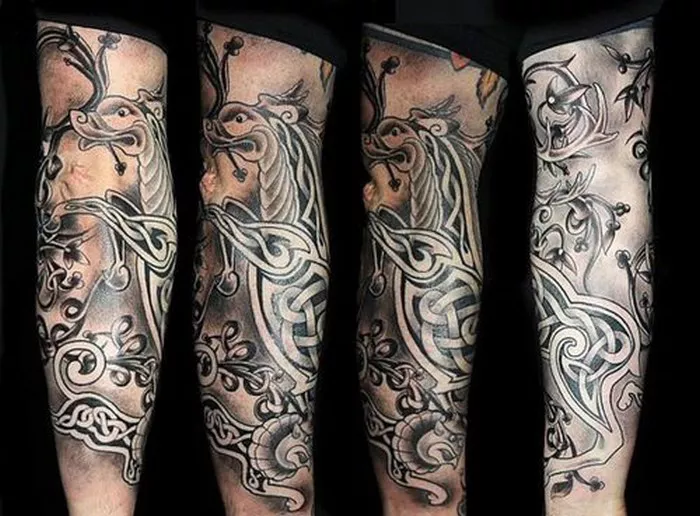Origins and History:
Celtic tattoos trace their origins back to the ancient Celtic warriors who inhabited regions such as Ireland, Wales, and Scotland, primarily in the British Isles. These fierce warriors, known for their bravery and indomitable spirit, adorned their bodies with intricate tattoos as a mark of identity, honor, and protection.
The process of tattooing among the ancient Celts was a sacred ritual, often performed by skilled artisans within their communities. The ink used for these tattoos was derived from the Woad plant, which produced a distinctive blue dye. With this natural pigment, the Celtic warriors would adorn their chests and arms with elaborate designs, each carrying profound symbolism and significance.
Design Elements:
Celtic tattoos are renowned for their complex and mesmerizing design elements, each imbued with profound symbolism and meaning:
1. Knotwork: Intricate interwoven patterns symbolizing eternity and interconnectedness. These knots, with no beginning or end, represent the cyclical nature of life and the eternal bond between individuals.
2. Spirals: Representing the continuous journey of life, death, and rebirth, spirals in Celtic tattoos symbolize growth, transformation, and the perpetual cycle of existence.
3. Animals: Depictions of animals such as wolves, birds, and snakes are prevalent in Celtic tattoos, each carrying its own symbolic significance. Wolves symbolize strength and loyalty, birds represent freedom and spirituality, while snakes signify rebirth and renewal.
4. Crosses: The Celtic cross is a fusion of Christian and pagan symbolism, embodying spiritual unity and the harmonious balance between the earthly and divine realms. It also represents the four elements of nature – earth, air, fire, and water.
5. Triskeles: Triple spirals symbolizing various concepts such as land, sea, and sky, as well as the interconnectedness of past, present, and future. The triskele is a potent symbol of progress, personal growth, and the cyclical nature of time.
6. Tree of Life: Representing the interconnectedness of all living beings and the cyclical nature of existence, the Tree of Life is a powerful symbol of wisdom, growth, and ancestral heritage.
Symbolism and Meanings:
Each element in a Celtic tattoo carries profound symbolism and meaning:
1. Knotwork: Symbolizes eternal love, unity, and continuity, reflecting the unbreakable bond between individuals or communities.
2. Spirals: Represent life’s journey, transformation, and the perpetual cycle of existence, reminding us of the constant flux and change inherent in life.
3. Animals: Signify strength, protection, and our deep connection to the natural world, serving as guardians and guides on our spiritual journey.
4. Crosses: Reflect faith, spirituality, and the harmonious balance between the earthly and divine realms, bridging the gap between the material and spiritual worlds.
5. Triskeles: Symbolize progress, personal growth, and the interconnectedness of past, present, and future, reminding us of the cyclical nature of time and existence.
6. Tree of Life: Represents the interconnectedness of all living beings, wisdom, and ancestral heritage, serving as a potent symbol of growth, renewal, and the cyclical nature of existence.
Placement and Styles:
Ancient Celts typically adorned their bodies with tattoos on prominent areas such as the arms, chest, and back, showcasing their intricate designs with pride and honor. These tattoos varied in style, ranging from bold lines to intricate details, each reflecting the individual’s personality, status, and cultural heritage.
Modern Interpretations:
In contemporary times, Celtic tattoos continue to captivate and inspire people from all walks of life. While still rooted in ancient symbolism and tradition, modern Celtic tattoos often incorporate innovative techniques and styles, reflecting the individual’s unique personality and beliefs.
Many people today choose Celtic tattoos as a way to honor their heritage, express their spirituality, or simply appreciate the timeless beauty of these ancient designs. Whether it’s a simple knotwork pattern or a complex depiction of the Tree of Life, Celtic tattoos serve as a powerful reminder of our deep connection to the past, present, and future.
In conclusion, ancient Celtic tattoos are not merely decorative markings but intricate symbols of identity, spirituality, and cultural heritage. With their timeless beauty and profound symbolism, these tattoos continue to inspire awe and admiration, bridging the gap between the ancient past and the modern world.

